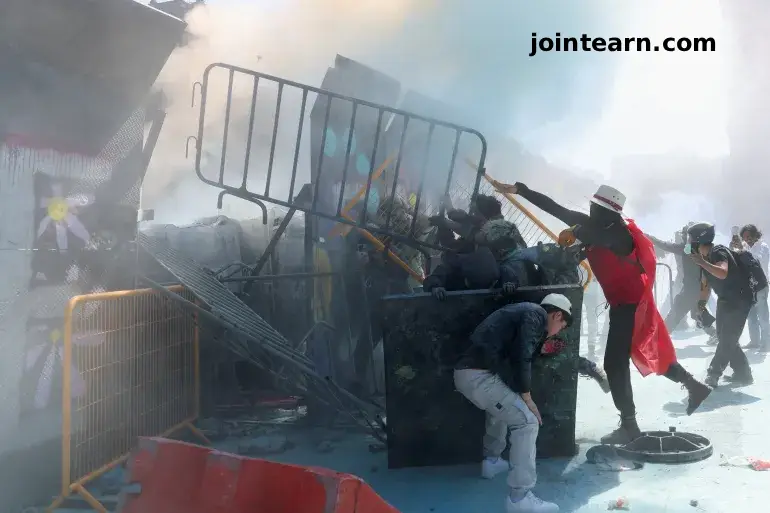
Thousands of demonstrators took to the streets across Mexico on Saturday, in a wave of protests organized largely by Generation Z activists, demanding action against escalating crime, systemic corruption, and impunity. The demonstrations, which took place in major cities including Mexico City, drew attention both nationally and internationally for their scale and intensity.
While the movement is led by younger Mexicans, the rallies also included participants from older generations, opposition party supporters, and the supporters of the recently assassinated Michoacan Mayor Carlos Manzo, who was tragically killed at a public event earlier this month.
Clashes at the National Palace in Mexico City
In the capital, a smaller, hooded group of protesters attempted to dismantle fences around the National Palace, the residence of President Claudia Sheinbaum. The action quickly escalated into violent clashes with riot police, who deployed tear gas to disperse the demonstrators.
According to Mexico City’s Public Safety Secretary Pablo Vazquez, approximately 100 police officers were injured, with 40 requiring hospital treatment. Additionally, 20 civilians were injured during the confrontations, and 20 protesters were arrested while another 20 were referred for administrative offenses.
Local media outlet El Universal reported that security forces both fired tear gas and threw stones at the protesters. “With their shields and stones, they physically assaulted young demonstrators in Zócalo square,” the outlet noted, highlighting the tense standoff between authorities and citizens.
Generation Z Leads the Movement
The protests were organized under the banner of “Generation Z Mexico”, a youth-led movement claiming to be non-partisan and focused on holding the government accountable for violence, corruption, and abuse of power.
Despite the official message, controversy surrounds the authenticity of the movement. Some social media influencers from Gen Z withdrew their support for Saturday’s march, while prominent figures such as former President Vicente Fox and billionaire Ricardo Salinas Pliego publicly expressed solidarity.
President Sheinbaum has accused right-wing political factions of attempting to infiltrate the movement, using social media bots to boost attendance artificially.
National Context: A Pattern of Youth-Led Protests
The involvement of young people in civic protests is part of a broader international trend. Across Asia and Africa in 2025, Generation Z activists have mobilized against government corruption, inequality, and democratic backsliding.
For example:
- In Nepal, mass youth protests following a social media ban forced former Prime Minister KP Sharma Oli to resign.
- In Madagascar, sustained demonstrations over water and electricity shortages exposed government failures, eventually leading to President Andry Rajoelina fleeing the country and a change in leadership.
This global context has amplified discussions about the political influence and social consciousness of Generation Z worldwide.
Voices from the Streets: Why Mexicans Protest
Protesters in Mexico City expressed frustration over systemic problems like rampant crime and lack of accountability for violent crimes.
- Andres Massa, a 29-year-old business consultant, said, “We need more security,” waving the pirate skull flag, which has become an international symbol of Generation Z protests.
- Claudia Cruz, a 43-year-old physician, emphasized the link between public safety and healthcare, noting that doctors also face threats in a country plagued by insecurity.
The assassination of Michoacan Mayor Carlos Manzo, who had taken a stand against drug cartels, fueled further anger. His supporters staged protests not only in Michoacan towns like Uruapan and Patzcuaro, but also traveled to Mexico City to join the broader demonstrations.
Rosa Maria Avila, a 65-year-old participant from Patzcuaro, remarked, “The state is dying. He was killed because he had the courage to confront delinquents.”
Government Response and Implications
Since assuming office in October 2024, President Claudia Sheinbaum has maintained high approval ratings, exceeding 70% in her first year. However, the administration has faced mounting criticism over security policy failures, highlighted by high-profile violent incidents like Manzo’s assassination.
Public safety concerns remain a central theme in the ongoing protests, signaling potential challenges for Sheinbaum as her government navigates rising public frustration and international scrutiny.
Conclusion
The 2025 Generation Z protests in Mexico reflect a growing youth-driven movement demanding accountability, security, and an end to corruption. While clashes in Mexico City’s Zócalo illustrate the volatility of such civic actions, the protests underscore the broader societal demand for reform and justice in Mexico.
As the movement evolves, it remains to be seen whether Generation Z can sustain momentum, influence policy, and catalyze long-term change in one of Latin America’s most dynamic political landscapes.


Leave a Reply